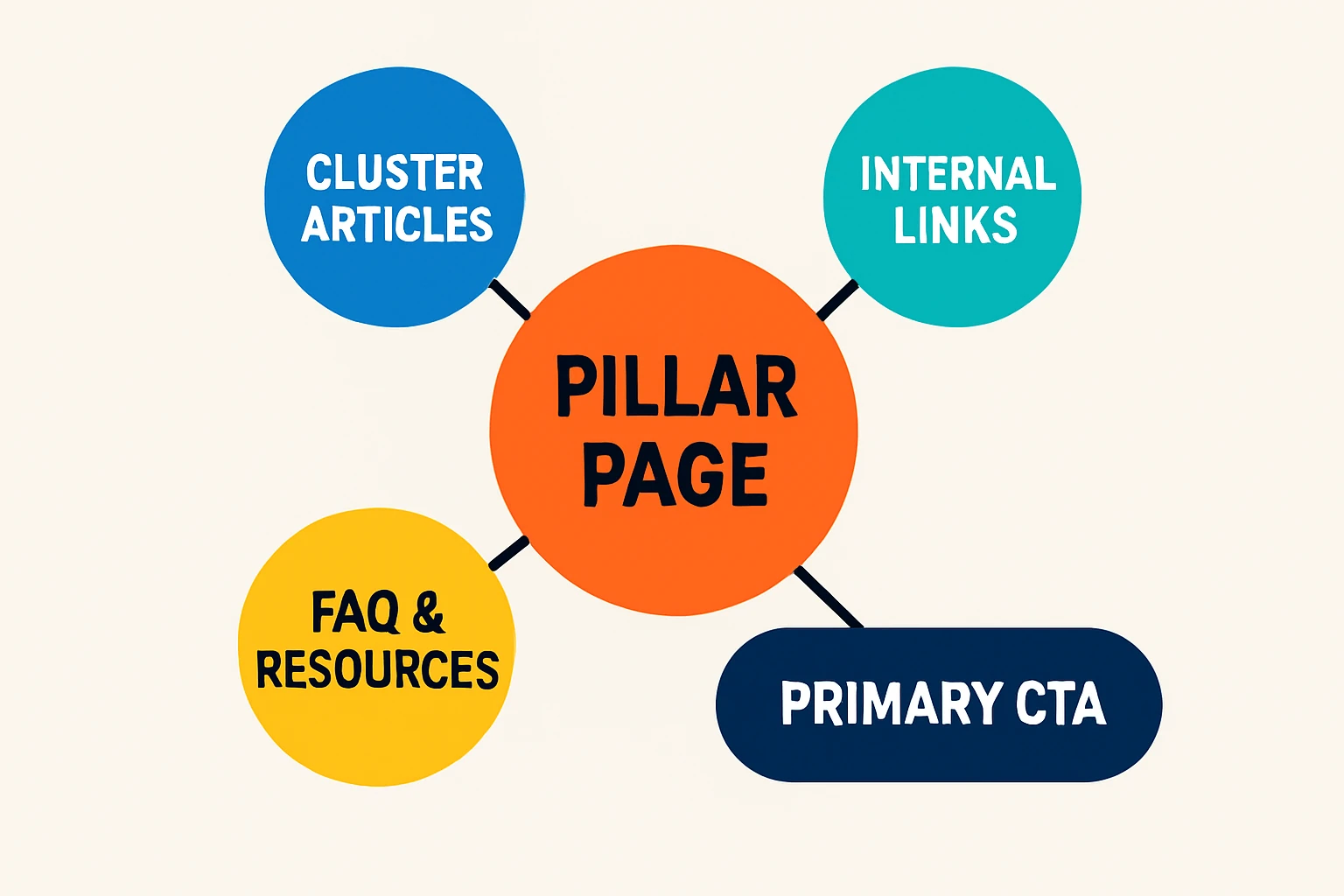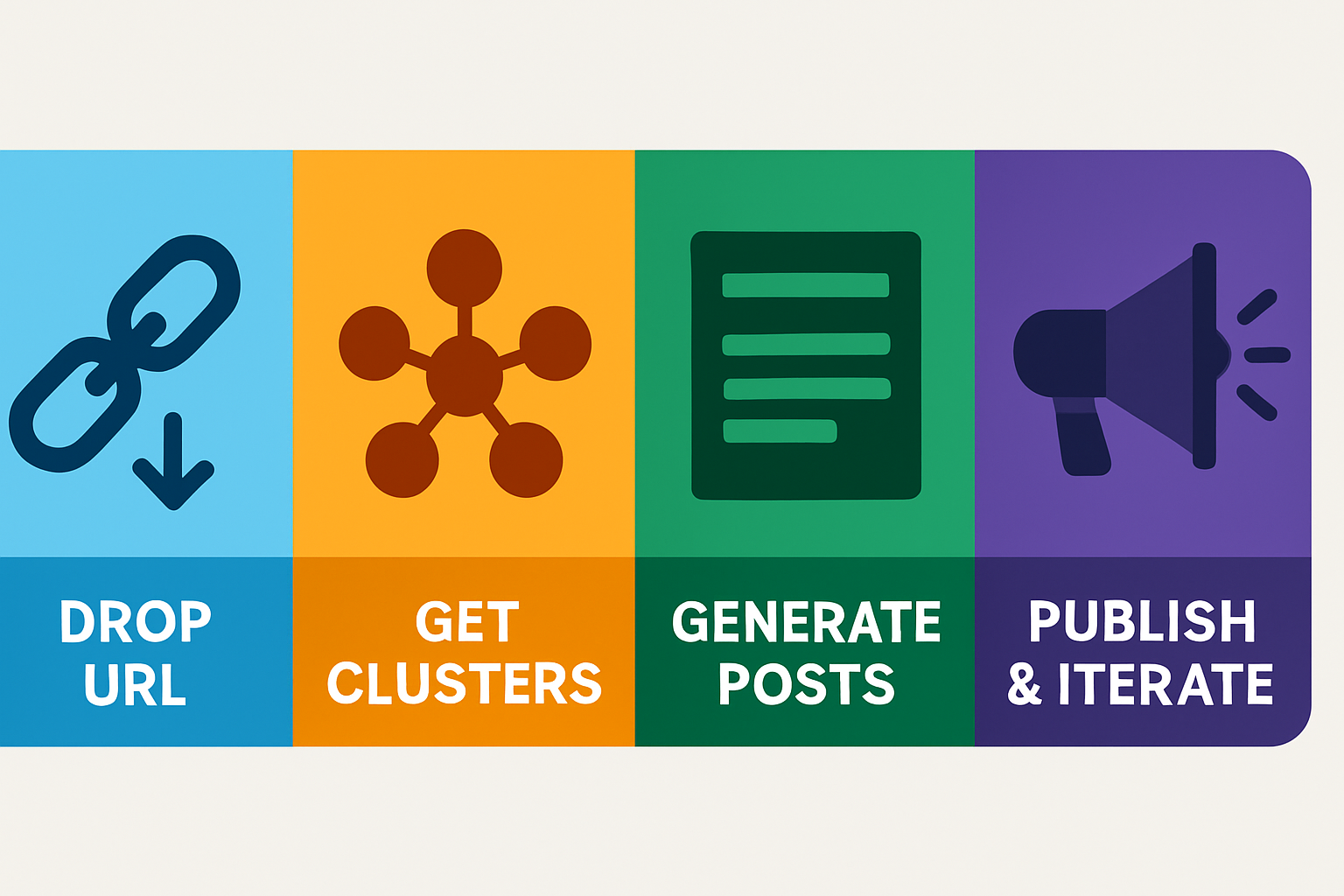If you need an SEO pillar page template and a plug-and-play listicle template you can publish this week, you’re in the right place. This guide gives you copy-ready frameworks plus a simple workflow to scale them.
You’ll get: crisp definitions, a complete pillar page structure, a listicle framework that converts, on-page checklists, industry examples, and a 10-minute/week way to automate it with SEOsolved.
Who this template-driven guide is for (and what you’ll get)
This is for marketers, founders, and in-house teams who are solution-aware and need a ready-to-use pillar page template and listicle template. You want to execute fast, cover topic clusters, and ship high-quality content with minimal lift.
Copy-and-paste templates: pillar page + list post
Skimmable topic cluster map and internal linking tips
2025-ready on-page SEO checklist (schema, semantics, UX)
Industry examples (SaaS, ecommerce, local)
Lightweight editorial SOP to publish at scale
Transaction-ready readers: you’ll also see where to add contextual CTAs that convert without hurting informational value.
Pillar pages and listicles, defined in 60 seconds
Both formats live inside a topic cluster model: one authoritative hub (the pillar page) supported by cluster articles, like listicles, that target long-tail queries and interlink back to the hub.
For background, see topic cluster explainers from Conductor, HubSpot, and Semrush.
What is a pillar page?
Definition: A pillar page is the authoritative hub for a broad topic. It introduces all key subtopics, links to in-depth cluster posts, answers FAQs, and provides tools/resources—earning topical authority and rankings for many related keywords.
Purpose: coverage, navigation, internal linking, trust
Role: hub in a hub-and-spoke cluster
Structure: TOC, subtopic summaries, FAQs, resources, primary CTA
What is a listicle?
Definition: A listicle is a structured list post (e.g., tools, steps, examples, mistakes) built to satisfy a specific long-tail intent, add proof, and nudge readers to deeper content or conversion.
Best for: comparisons, checklists, mistakes, examples, tool roundups
Supports: the pillar via internal links and conversion assists
Format: repeatable item block with problem, proof, action
Aspect | Pillar Page | Listicle |
|---|---|---|
Primary Goal | Topical authority & hub navigation | Capture long-tail intent & assist conversions |
Keyword Focus | Broad head term | Specific variants / modifiers |
Length | In-depth, comprehensive | Focused, scannable |
Interlinking | Links out to clusters; clusters link back | Links to pillar and sibling posts |

The complete Pillar Page Template (copy-and-paste)
Use this pillar page template to structure any hub topic. Replace bracketed text and keep sections skimmable.
1) Hero + Value Proposition Block
H1: [TARGET KEYWORD] — The Only Guide You Need
Subhead (1–2 lines): [PAIN/OUTCOME] in [TIMEFRAME] with proven steps
Primary CTA button: [TRY/DEMO/GET CHECKLIST] → [PRIMARY CTA URL]
Trust boosters: [# STATS], [BRIEF PROOF], [SOCIAL PROOF/REVIEWS]
2) Definition + Scope (What, Who, Why)
What: Concise definition of [CORE TOPIC]
Who: Best for [ICP/SEGMENTS] and not for [MISFIT]
Why now: [TREND/CHANGE] makes this essential
What’s inside: TOC bullets linking to sections
3) Topic Cluster Map (Skimmable Navigation)
Short intro to hub-and-spoke
Bulleted list of subtopics (H2/H3 anchors)
Internal links to cluster articles; mark “Start here” items
4) Subtopic Overviews (H2/H3 Summaries)
For each subtopic, write 150–250 words covering: definition, why it matters, first steps, link to in-depth post.
5) Visuals, Data, and Examples
Include 1–2 charts or mini case snapshots
Add relevant, sourced stats to boost E-E-A-T
Cross-link to examples library or case studies
6) FAQs (Entity + Intent Coverage)
5–10 FAQs that capture “People Also Ask” queries
One-paragraph answers; add FAQPage schema
Link to related sections or cluster posts
7) Tools + Resources
Include calculators, templates, and checklists
Link to your product as a contextual solution
Maintain neutrality by including credible external resources
8) Primary CTA + Next Steps
Re-state the value in one sentence
Offer the most relevant next step (demo, quiz, template pack)
Remind readers what happens after the click
Example inspiration: Figma’s interactive color psychology hub and QuickBooks’ business structures guide are both strong pillar page blueprints that interlink extensively and stay skimmable while being in-depth (examples here).
Pro tip: Keep a table of contents, clear hierarchy, and internal links. These are consistent traits of high-performing hubs noted by Siteimprove and others.
On-page SEO checklist for your pillar page (2025-ready)
Meta, headings, and semantic coverage
Title tag: include the head term + a benefit (≤ 60 chars)
Meta description: clarify value and include a subtle CTA. Need help? Try our meta description generator.
Headings: map H2/H3s to subtopics and variants; add entities naturally
Glossary: define key entities to win featured snippets
Internal links: each subtopic links to/from its in-depth article
Schema markup and rich results
Organization, BreadcrumbList, and FAQPage schema
Use Article schema for clusters; add author and datePublished
Make breadcrumbs mirror your hub-and-spoke navigation
Accessibility and performance
Alt text for all images; descriptive link anchors
Core Web Vitals: LCP ≤ 2.5s, CLS ≤ 0.1, INP ≤ 200ms
Readable contrast and font sizes; keyboard navigability
Helpful resources: On hub models and design traits, see overviews by Siteimprove and Backlinko.
CTA: Want this checklist baked into your drafts? Automate it with SEOsolved and ship optimized pillars in minutes. Stat Ranking Today.
Pillar Page Template examples by industry
SaaS: Customer Onboarding Hub
H1: Customer Onboarding: The Complete Guide
Subtopics: Onboarding emails, in-app tours, activation metrics, NPS
FAQs: Time-to-value benchmarks, onboarding vs. adoption
CTA: See onboarding checklist (downloads lead magnet)
Ecommerce: Sustainable Footwear Guide
H1: Sustainable Shoes: Materials, Sizing, and Care
Subtopics: Materials explained, sizing guide, care, comparison charts
FAQs: Vegan vs. recycled, washing tips, durability
CTA: Shop eco-friendly bestsellers (with size guide link)
Local Services: Home Solar Education Center
H1: Home Solar: Costs, Incentives, and Installation in [CITY]
Subtopics: Permit process, financing options, net metering, installers
FAQs: Timeline, HOA rules, roof suitability
CTA: Book a free assessment
Related reading: see a practical niche example in our SEO for real estate agents playbook.
The Ultimate Listicle Template (copy-and-paste)
Use this listicle template to produce consistent, high-converting list posts that support your pillar and capture long-tail queries.
Headline formulas that earn clicks
[#] [TOOLS/EXAMPLES/TIPS] for [AUDIENCE] to [OUTCOME] in [TIMEFRAME]
[#] Common [MISTAKES] (and How to Fix Them)
Best [CATEGORY] for [USE CASE]: [#] Tested Picks
[#]-Step [PROCESS] You Can Run Today
Intro hook + Promise (30–60 words)
Open with a pain and payoff. Signal selection criteria and what readers will get. Example: “Struggling to choose [CATEGORY]? We tested [#] options for [AUDIENCE]. Below are the [CRITERIA]-based picks and when to use each, plus quick-start steps.”
List item pattern (Repeatable block)
Item Name — one-line positioning
Problem it solves: [PAIN]
Proof: [DATA/QUOTE/RESULT] with a source
Action: [HOW TO START IN 2–3 STEPS]
Deeper dive: link to your pillar or a cluster article
Proof elements and sources
Back claims with credible sources and simple visuals
Use first-party data where possible; otherwise cite reputable publications
Add screenshots, short charts, or mini case blurbs
Closing CTA + Next Steps
Summarize the criteria and who each pick is for
Invite readers to a relevant template, demo, or quiz
Reinforce the next action’s value and time required
“What is listicles?” vs “What is a listicle?” (search nuances)
Both variations appear in search and People Also Ask. Capture them by including one H2/H3 with the exact phrase and addressing it in your FAQ and FAQPage schema. Use one canonical definition and avoid duplicating content across sections.
10 listicle angles that rank and convert
Beginner guides and “mistakes to avoid”
[#] Beginner Tips for [TOPIC]
[#] Mistakes to Avoid in [TOPIC]
[#] Glossary Terms Every [AUDIENCE] Should Know
Comparisons, checklists, and tool roundups
Best [CATEGORY] Tools for [USE CASE]
The Ultimate [TOPIC] Checklist
[#] Alternatives to [COMPETITOR] Compared
Case studies, ROI calculators, and implementation steps
[#] Real-World Case Studies of [TOPIC] ROI
[#]-Step Implementation Plan for [TOPIC]
ROI Calculator: Estimate Your [METRIC] Gains
Editorial SOP: turning templates into publish-ready content
Briefing checklist (inputs, intent, SERP scan)
Audience: ICP, JTBD, funnel stage
Intent: informational vs. commercial vs. transactional
SERP: top 10 patterns, gaps, featured snippets
Outline: pillar/listicle template populated with subtopics
Distribution plan: pair with a social media post generator for faster reach
Quality bar (E-E-A-T, depth, originality)
Experience: show screenshots, process, or results
Expertise: cite reputable sources; add author credentials
Authority: interlink related content; include glossary/FAQs
Trust: transparent sourcing and clear next steps
Publishing cadence and content velocity
Target 1 pillar + 8–20 cluster posts per month
Batch briefs; keep templates consistent across writers
Map KPIs to funnel stages and iterate quarterly
How to use SEOsolved to auto-generate pillar pages and listicles
SEOsolved automates painful steps: competitor analysis, keyword discovery, clustering, outlines, and draft generation—so you can execute this pillar page template and listicle template in ~10 minutes/week and reclaim 80+ hours/month.
1) Drop your URL and goals
Paste your site, choose your audience and outcomes. SEOsolved analyzes competitors and surfaces 500+ ranking keywords aligned to intent.
2) Get your topic clusters and pillar outline
Receive a ready-made pillar structure mapped to subtopics and entities, plus internal link recommendations using a hub-and-spoke model.
3) Generate 30–60 listicles and supporting posts monthly
Automatically create in-depth, sourced list posts and cluster content that follow your brand voice and link back to the pillar.
4) Publish, interlink, and iterate with source-backed drafts
Export, schedule, and update content with built-in sourcing and optimization prompts. Add journey-aligned CTAs—need inspiration? See our guide to customer journey mapping.

Why teams choose SEOsolved:
Eliminates manual research and clustering
Delivers source-backed drafts that support E-E-A-T
Builds interlinking and schema guidance into the plan
Scales content velocity without extra headcount
CTA: Want your pillar page outlined and supporting listicles queued by next week? Stat Ranking Today.
Measurement: KPIs to track after publishing
Coverage and visibility
Impressions and average position (Google Search Console)
Keyword growth within the cluster (head + long-tail)
Pages ranking per subtopic; SERP feature ownership
Engagement and trust
Time on page and scroll depth on the pillar
FAQ interactions and outbound clicks to clusters
Bounce rate for primary intents; Core Web Vitals
Revenue impact
Direct conversions from pillar and cluster CTAs
Assisted conversions from listicles (multi-touch)
Sales velocity or lead quality shifts post-launch
Common pitfalls (and quick fixes)
Thin coverage: Add subtopic summaries and link to depth articles
Intent mismatch: Align H1/H2s with the dominant SERP intent
Orphaned listicles: Ensure every list post links to/from the pillar
No snippet strategy: Add concise definitions and schema-backed FAQs
Weak distribution: Repurpose with a social post generator to amplify reach
Next steps: Grab the templates and start ranking
You now have a complete pillar page template, a repeatable listicle template, a 2025-ready on-page checklist, and an SOP to ship consistent content.
Launch with SEOsolved in 10 minutes/week
Let SEOsolved do the heavy lifting—clustering, outlines, drafts, and interlinking. Reclaim 80+ hours/month and focus on strategy and distribution.
CTA: Stat Ranking Today (https://www.seosolved.com/)
Build your pillar hub and 30–60 supporting listicles without the busywork. Stat Ranking Today.
FAQ
What is a pillar page?
A comprehensive hub covering a broad topic with links to in-depth cluster articles, FAQs, and resources.
What is listicles?
A search variant of “what is a listicle”; it refers to a list-form article used to target specific long-tail intents.
How many listicles should support one pillar?
Start with 8–20 cluster posts, then expand based on keyword gaps and performance.
Do I need schema on my pillar page?
Yes. Use Organization, BreadcrumbList, and FAQPage; add Article schema to cluster posts.
How fast can I publish with SEOsolved?
Most teams generate a pillar outline and 30–60 listicles monthly with ~10 minutes/week of input.
